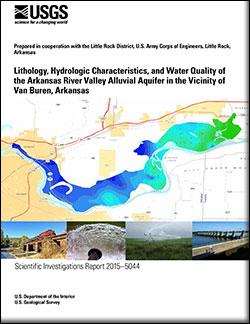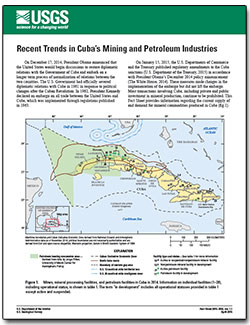Filters: Types: Citation (X) > Types: OGC WFS Layer (X) > partyWithName: U.S. Geological Survey (X)
536 results (61ms)|
Filters
Date Range
Extensions
Types
Contacts
Categories Tag Types
|
The travel time map was generated using the Pedestrian Evacuation Analyst model from the USGS. The travel time analysis uses ESRI's Path Distance tool to find the shortest distance across a cost surface from any point in the hazard zone to a safe zone. This cost analysis considers the direction of movement and assigns a higher cost to steeper slopes, based on a table contained within the model. The analysis also adds in the energy costs of crossing different types of land cover, assuming that less energy is expended walking along a road than walking across a sandy beach. To produce the time map, the evacuation surface output from the model is grouped into 1-minute increments for easier visualization. The times in...
Categories: Data;
Types: Citation,
Downloadable,
Map Service,
OGC WFS Layer,
OGC WMS Layer,
Shapefile;
Tags: Humboldt County,
evacuation,
hazard preparedness,
hazards,
tsunamis,
This dataset describes irrigation water use in Kansas in 2015. Volumes of water used, irrigated area, and average irrigation application depths are provided for three sets of subareas: (1) Irrigation water use analysis regions that include Groundwater Management Districts (GMDs) with the areas outside of GMDs divided into eastern, central, and western Kansas; (2) Regional Planning Areas (RPAs), which are 14 areas determined by the Kansas Water Office based on hydrologic and administrative boundaries, each with a set of goals outlined in the Kansas Water Vision (https://kwo.ks.gov/water-plan/water-vision); and (3) the 105 Kansas counties. Volumes of water used, irrigated area, and average application depths are also...
This dataset contains images obtained from unmanned aerial systems (UAS) flown in the Cape Cod National Seashore. The objective of the field work was to evaluate the quality and cost of mapping from UAS images. Low-altitude (approximately 120 meters above ground level) digital images were obtained from cameras in a fixed-wing unmanned aerial vehicle (UAV) flown from the lawn adjacent to the Coast Guard Beach parking lot on 1 March, 2016. The UAV was a Skywalker X8 flying wing operated by Raptor Maps, Inc., contractors to the U.S. Geological Survey. U.S. Geological Survey technicians deployed and mapped 28 targets that appear in some of the images for use as ground control points. All activities were conducted according...
Surveys of the bathymetry and backscatter intensity of the sea floor south of Long Island, New York, were carried out in November 1998 using a Simrad EM1000 multibeam echosounder mounted on the Canadian Coast Guard ship Frederick G. Creed. The purpose of the multibeam echosounder surveys was to explore the bathymetry and backscatter intensity of the sea floor in several areas off the southern coast of Long Island along the 20-meter isobath. Survey areas offshore of Fire Island Inlet, Moriches Inlet, Shinnecock Inlet, and southwest of Montauk Point were about 1 kilometer (km) wide and 10 km long. The area was mapped by the U.S. Geological Survey with support from the Canadian Hydrographic Service and the University...
Parameter values for the Precipitation Runoff Modeling System (PRMS) using the National Hydrologic Modeling (NHM) infrastructure. The contents of the attached zip folder are a direct download from the USGS bitbucket repository titled National Hydrologic Model Parameter Database (NhmParamDb) (https://my.usgs.gov/bitbucket/projects/MOWS/repos/nhmparamdb/browse). The NhmParamDb is stored using a Git version control system, which tracks modifications to the master dataset through 'commits'. Each commit has a unique code to allow for retroactive identification of any given component of the repository. The specific attributes of the download contained in this release are: Date: May 8, 2017 Commit: 6ccc41d5688 Filename:...

Categories: Publication;
Types: Citation,
Map Service,
OGC WFS Layer,
OGC WMS Layer,
OGC WMS Service;
Tags: Scientific Investigations Report
Shapefile containing the boundaries of the eight Climate Adaptation Science Centers (CASCs).
Categories: Data;
Types: Citation,
Downloadable,
Map Service,
OGC WFS Layer,
OGC WMS Layer,
Shapefile;
Tags: Climate Science Center,
United States, U.S. Affiliated Pacific Islands,
boundaries

Categories: Publication;
Types: Citation,
Map Service,
OGC WFS Layer,
OGC WMS Layer,
OGC WMS Service;
Tags: Fact Sheet
Brackish groundwater (BGW), defined for this assessment as having a dissolved-solids concentration between 1,000 and 10,000 milligrams per liter is an unconventional source of water that may offer a partial solution to current (2016) and future water challenges. In support of the National Water Census, the U.S. Geological Survey has completed a BGW assessment to gain a better understanding of the occurrence and character of BGW resources of the United States as an alternative source of water. Analyses completed as part of this assessment relied on previously collected data from multiple sources, and no new data were collected. One of the most important contributions of this assessment was the creation of a database...
Categories: Data;
Types: Citation,
Downloadable,
Map Service,
OGC WFS Layer,
OGC WMS Layer,
OGC WMS Service;
Tags: Alaska,
American Samoa,
Guam,
Hawaii,
Puerto Rico,
This data shows select streamgage locations throughout the Red River of the North Basin upstream of Emerson, Manitoba, and basin outlines for eight subbasins..
Categories: Data;
Types: Citation,
Downloadable,
Map Service,
OGC WFS Layer,
OGC WMS Layer,
Shapefile;
Tags: Crookston,
Emerson,
Fargo,
Halstad,
Kindred,

This part of DS 781 presents data for the transgressive contours for the Point Conception to Hueneme Canyon, California, region. The vector file is included in "TransgressiveContours_PointConceptionToHuenemeCanyon.zip," which is accessible from http://dx.doi.org/10.5066/F7891424. As part of the USGS's California State Waters Mapping Project, a 50-m grid of sediment thickness for the seafloor within the 3-nautical mile limit between Point Conception and Hueneme Canyon was generated from seismic-reflection data collected in 2014 (USGS activity 2014-632-FA) supplemented with outcrop and geologic structure (fault) information following the methodology of Wong (2012). Water depths determined from bathymetry data were...
Categories: Data;
Types: Citation,
Downloadable,
Map Service,
OGC WFS Layer,
OGC WMS Layer,
Shapefile;
Tags: Carpinteria,
Coal Oil Point,
Gaviota,
Hueneme Canyon,
Pacific Ocean,

This part of DS 781 presents data for the isopachs for the Point Conception to Hueneme Canyon, California, region. The vector data file is included in "Isopachs_PointConceptionToHuenemeCanyon.zip," which is accessible from https://doi.org/10.5066/F7891424. As part of the USGS's California State Waters Mapping Project, a 50-m grid of sediment thickness for the seafloor within the 3-nautical mile limit between Point Conception and Hueneme Canyon was generated from seismic-reflection data collected in 2014 (USGS activity 2014-632-FA) supplemented with outcrop and geologic structure (fault) information following the methodology of Wong (2012). This sediment thickness layer was merged with a previously published sediment...
Categories: Data;
Types: Citation,
Downloadable,
Map Service,
OGC WFS Layer,
OGC WMS Layer,
Shapefile;
Tags: Carpinteria,
Coal Oil Point,
Gaviota,
Hueneme Canyon,
Pacific Ocean,
Spatial polygons of vegetation zones in 1975 for wetlands; P1, P2, and P4 within the Cottonwood Lake Study Area, Stutsman County, North Dakota. Created from a collection of digital orthorectified images from aerial photographs of the study area acquired during 1975 using Stewart and Kantrud classification system.
Categories: Data;
Types: Citation,
Downloadable,
Map Service,
OGC WFS Layer,
OGC WMS Layer,
Shapefile;
Tags: Cottonwood Lake Study Area,
EARTH SCIENCE>BIOSPHERE>AQUATIC ECOSYSTEMS>WETLANDS>LACUSTRINE WETLANDS,
EARTH SCIENCE>BIOSPHERE>AQUATIC ECOSYSTEMS>WETLANDS>PALUSTRINE WETLANDS,
EARTH SCIENCE>BIOSPHERE>TERRESTRIAL ECOSYSTEMS>WETLANDS>LACUSTRINE WETLANDS,
EARTH SCIENCE>BIOSPHERE>TERRESTRIAL ECOSYSTEMS>WETLANDS>PALUSTRINE WETLANDS,
Categories: Data,
Publication;
Types: Citation,
Downloadable,
Map Service,
OGC WFS Layer,
OGC WMS Layer,
Shapefile;
Tags: MONITORING 5-PHYSICAL SCIENCE
From its origin in rugged granitic highlands of the central Brooks Range, the Noatak River flows westward between the De Long Mountains and the Baird Mountains before turning south to enter Kotzebue Sound. Glaciers of middle and late Pleistocene age entered the Noatak River valley from the east, north, and south. Glaciers flowed down the upper Noatak River valley from the rugged peaks at its head, merging with tributary glaciers that issued from cirque-headed valleys along its south flank. Farther downvalley, small glaciers flowed northward from the Baird Mountains and much larger glaciers issued from the De Long Mountains. The De Long Mountains glaciers expanded southward to cover parts of the Noatak valley floor;...
Categories: Data,
Publication;
Types: Citation,
Downloadable,
Map Service,
OGC WFS Layer,
OGC WMS Layer,
Shapefile;
Tags: MONITORING 5-PHYSICAL SCIENCE
This report contains water-quality and sediment-quality data from samples collected in the Yukon River Basin from March through September during the 2004 water year (WY). Samples were collected throughout the year at five stations in the basin (three on the main stem Yukon River, one each on the Tanana and Porcupine Rivers). A broad range of physical, chemical, and biological analyses are presented.
Categories: Data,
Publication;
Types: Citation,
Downloadable,
Map Service,
OGC WFS Layer,
OGC WMS Layer,
Shapefile;
Tags: Monitoring 2-Standardized Stream and Lake Information
The Geographic Names Information System (GNIS) is the Federal standard for geographic nomenclature. The U.S. Geological Survey developed the GNIS for the U.S. Board on Geographic Names, a Federal inter-agency body chartered by public law to maintain uniform feature name usage throughout the Government and to promulgate standard names to the public. The GNIS is the official repository of domestic geographic names data; the official vehicle for geographic names use by all departments of the Federal Government; and the source for applying geographic names to Federal electronic and printed products of all types. See http://geonames.usgs.gov for additional information.
Types: Citation,
Map Service,
OGC WFS Layer,
OGC WMS Layer,
OGC WMS Service;
Tags: Antarctica,
Borough,
Census Area,
Commonwealth,
County,
Floods, spatially complex water flows, and organism movements all generate important fluxes of aquatic-derived materials into terrestrial habitats, counteracting the gravity-driven downhill transport of matter from terrestrial-to-aquatic ecosystems. The magnitude of these aquatic subsidies isoften smaller than terrestrial subsidies to aquatic ecosystems but higher in nutritional quality, energy density, and nutrient concentration. The lateral extent of biological aquatic subsidies is typically small, extending only a few meters into riparian habitat; however, terrestrial consumers often aggregate on shorelines to capitalize on these high-quality resources. Although the ecological effects of aquatic subsidies remain...
Categories: Data,
Publication;
Types: Citation,
Map Service,
OGC WFS Layer,
OGC WMS Layer,
OGC WMS Service;
Tags: ECOSYSTEM FUNCTIONS,
ECOSYSTEM FUNCTIONS,
Federal resource managers,
LCC Network Science Catalog,
Publication,
How local geomorphic and hydrologic features mediate the sensitivity of stream thermal regimes to variation in climatic conditions remains a critical uncertainty in understanding aquatic ecosystem responses to climate change. We used stable isotopes of hydrogen and oxygen to estimate contributions of snow and rainfall to 80 boreal streams and show that differences in snow contribution are controlled by watershed topography. Time series analysis of stream thermal regimes revealed that streams in rain-dominated, low-elevation watersheds were 5–8 times more sensitive to variation in summer air temperature compared to streams draining steeper topography whose flows were dominated by snowmelt. This effect was more pronounced...
Categories: Data,
Publication;
Types: Citation,
Map Service,
OGC WFS Layer,
OGC WMS Layer,
OGC WMS Service;
Tags: ECOSYSTEM FUNCTIONS,
ECOSYSTEM FUNCTIONS,
Federal resource managers,
LCC Network Science Catalog,
Publication,
OVERVIEW This report contains water-quality data collected from 84 sites in Tanana River basin during water years 2004 through 2006 (October 2003 through September 2006) as part of a cooperative study between the U.S. Geological Survey (USGS) and Alaska Department of Environmental Conservation (ADEC) Alaska Monitoring and Assessment Program (AKMAP), supported in part through the U.S. Environmental Protection Agency (USEPA) Office of Water, Cooperative Assistance Agreement X7-97078801. A broad range of chemical analyses are presented for 93 sets of samples collected at 59 tributaries to the Tanana River and at 25 locations along the mainstem. These data are to provide a means to assess baseline characteristics and...
Categories: Data,
Publication;
Types: Citation,
Downloadable,
Map Service,
OGC WFS Layer,
OGC WMS Layer,
Shapefile;
Tags: Monitoring 2-Standardized Stream and Lake Information
|

|